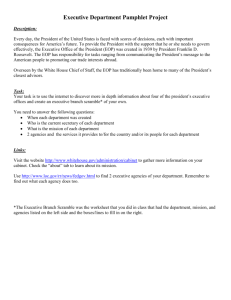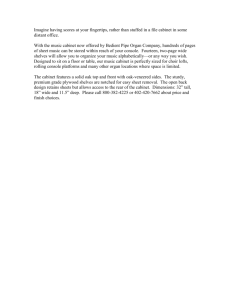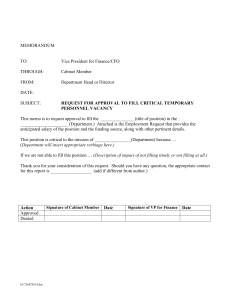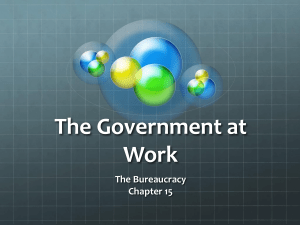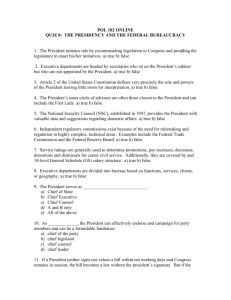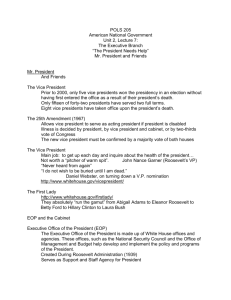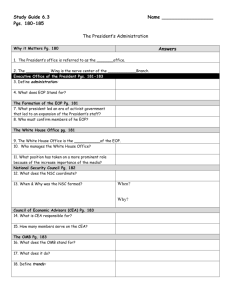The Presidency
advertisement
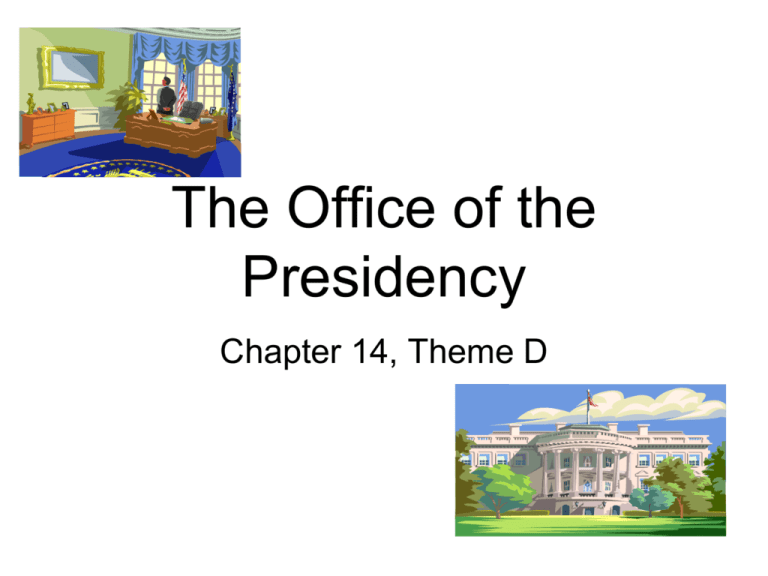
The Office of the Presidency Chapter 14, Theme D POP Quiz 14B 1.Explain one of the styles of staff organization from the reading. (pyramid, ad hoc, or circular) 2. Which of the groups mentioned in the text has the closest “propinquity” to the President? 3. In what part of the White House are the offices located? 4. Which agency in the EOP is most important? 5. What are “acting” appointments? WH Office • Work in the WH’s “West Wing.” • Discuss what & who makes up the White House Office. • http://www.whitehouse.gov/administration/staff • Why are these people called “The President’s People?” • How do they differ from the EOP and the Cabinet? The EOP • Discuss several components of the EOP. • http://www.whitehouse.gov/administration/eop • Outline the growth of these offices. • Why can’t the President rely on these agencies as much as the White House Office members? Cabinet Notes • Cabinet is comprised of 14 secretaries, Attorney General, VP, NSA, and other top officials like OMB, EPA, CEA, etc. • http://www.whitehouse.gov/photos-andvideo/video/inside-white-house-cabinet • http://www.whitehouse.gov/administration/cabinet • Cabinet appointments must be approved by Senate. • Many appointments are due to patronage. Examples? Cabinet Notes • Are 15 executive depts. Originally only 4. • Newest is the Dept. of Homeland Security (DHS), created in 2002. • Head of ea. dept. is called a secretary, except the Attorney General heads DOJ. Inner Cabinet • Comprised of 5 depts.: State, DOJ, Treasury, DOD, DHS • President meets with these secretaries on at least a weekly basis. • All are vital to US security. Outer Cabinet • The other 10 depts. make up the outer cabinet. • The pres. does not meet with these secretaries as much, usually only at Cabinet meetings. Names to Know • • • • Sec. Of State: John Kerry Sec. Of Treasury: Jack Lew Sec. Of Defense: Ash Carter Atty. Gen.: Eric Holder (Loretta Lynch) • Sec. Of DHS: Jeh Johnson Staff Structure Styles • Pyramid—Headed by Chief of Staff…info. and access flows thru that position – Describe – Advantages – Disadvantages • Ad Hoc—Senior advisors, friends, experts, etc. help make decisions – Describe – Advantages – Disadvantages • Circular—Dept. Secretaries, advisors, & assistants all report to President – Describe – Advantages – Disadvantages Activity • Act out each of the leadership styles. • Members of the Press will determine which style is best and why. • Discuss previous slide analysis. Chapter 14 Review • Detail the similarities and differences of the US President compared t the British Prime Minister. • List constitutional provisions, articles, sections, and amendments that relate to the Presidency. • List pertinent vocabulary related to the Presidency. • Distinguish the difference between formal and informal roles and powers of the President. • Outline the electoral college components, the pros/cons of the system, and its applications. • Understand the People who advise the President and the options to organize them. Assignment • Read Lesson 24 in WTP & pp. 408-414 in Wilson. • Take notes on what the bureaucracy is, the types of agencies, how it has changed, and what has caused its growth. • Due Friday!
